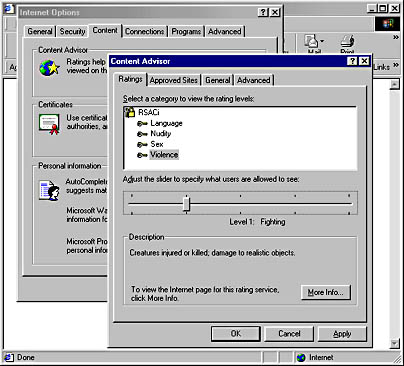Working with a Ratings System
Many people, especially parents, are concerned about the type of content available to minors on the Internet. The Internet is basically an open system of exchanging information without any built-in safeguards to control the types of content that can be downloaded to a browser. To help deal with this issue of safeguards, the World Wide Web Consortium (W3C) chartered the Platform for Internet Content Selection (PICS) group. According to the W3C, "PICS is an infrastructure for associating labels (metadata) with Internet content. It was originally designed to help parents and teachers control what children access on the Internet, but it also facilitates other uses for labels, including code signing and privacy." (For additional information about the PICS recommendations, visit the W3C PICS Web site at www.w3.org/PICS.)
The PICS recommendations consist of two specifications, one for creating a ratings system and one for creating rating labels. The first specification allows the establishment of a ratings system with multiple categories. This is in contrast to the Motion Picture Association of America (MPAA) ratings system, which has only one category containing the five values G, PG, PG-13, R, and NC-17. The PICS specification does not define a ratings system, but it provides a language for defining such a system.
The actual rating information comes in the form of a rating label. The label can appear as part of the header in an HTML document, on a separate Web site, or just about anywhere the browser has been told to look for the label. The rating line is a combination of category and value pairs that reflect the nature of content found on the page, as the final line of the <META> tag in the following code demonstrates.
<HEAD> <META http-equiv="PICS-Label" content=` (PICS-1.1 "http://www.rsac.org/ratingsv01.html" l gen false comment "RSACi North America Server" for "http://www.myawesomelycoolwebsite.com" on "1998.11.07T17:38-0800" r (n 0 s 0 v 1 l 2))'> </HEAD> |
The PICS approach works by matching the label to its associated ratings system, and there are several ratings systems available. For example, the Recreational Software Advisory Council has the RSACi ratings system—supported in Internet Explorer and MicroSystem's Cyber Patrol Software—that provides five levels of four different categories, including violence, nudity, sex, and language (abbreviated to their first letters in the rating code above). SurfWatch has created a different system used by other products, such as Digital's AltaVista Web search engine.
Figure 22-10 shows the ratings of one system—Internet Explorer Content Advisor—that parents can use to set access levels on a home computer. If children (or anyone else using the computer) try to enter an area that contains a prohibited rating, their access to that site is restricted or denied.

Figure 22-10. The Internet Explorer Content Advisor allows users to restrict access to objectionable content.
Of course, ratings systems work only if content providers use them. For more information about having content rated through the RSACi or SurfWatch systems, visit their Web sites at www.rsac.org/homepage.asp and www1.surfwatch.com/.
This chapter covered a variety of interesting technologies available to creators of Web pages. Some of them work with a number of browsers, while others are supported only in the latest versions of Internet Explorer. The next chapter will explore techniques for creating cross browser Web pages and Web pages that degrade gracefully when they contain browser-specific technology.
EAN: 2147483647
Pages: 128